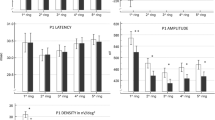Abstract
Background
Antimalarial drugs such as chloroquine (CQ) and hydroxychloroquine (HCQ) are mainly used in the treatment of rheumatologic diseases, and their use may be associated with irreversible retinal toxicity. Previous studies indicate early paracentral visual field loss (Humphrey 10-2) in patients taking HCQ". These paracentral defects appear before changes in other clinical parameters as visual acuity and fundoscopy. The mechanism of CQ toxicity remains unclear. It was reported that toxic doses of CQ administered for as long as 4.5 years to Rhesus monkeys caused an initial dramatic effect on ganglion cells, followed later by photoreceptors and RPE degeneration. The purpose of this study is to explore early retinal functional changes measured by frequency-doubling technology (FDT) in patients treated with hydroxychloroquine (HCQ).
Methods
Forty-eight eyes of 48 subjects treated with hydroxychloroquine (HCQ), with no signs of retinal toxicity, and 36 eyes of 36 age and sex-matched healthy subjects were enrolled in this cross-sectional, prospective, observational, case control study. Functional testing included frequency-doubling Humphrey-matrix perimetry (FDP), white-on-white Humphrey visual field perimetry (HFA), using the 24-2 and 10-2 threshold programs, multifocal electroretinogram (mfERG, Veris 4.9) and low contrast sensitivity (CS) measurement.
Results
FDP mean deviation (MD) was found to be significantly reduced in HCQ-treated patients compared to controls both in the 24-2 (−1.38 ± 2.41 dB vs 0.21 ± 1.83dB, p < 0.01) and in the 10-2 program (−0.97 ±2.88 dB vs 0.15 ± 1.72dB, p < 0.01). FDP pattern standard deviation (PSD) was found to be significantly worse in HCQ-treated patients compared to controls both in the 24-2 (2.70 ± 0.65 dB vs 2.41 ± 0.31 dB, p < 0.01 and in the 10-2 program (2.86 ± 0.48 dB vs 2.48 ±0.39 dB, p < 0.01). HFA PSD and CS was also significantly reduced in HCQ patients, while response amplitude densities (RAD) were similar between patients and controls. A statistically significant difference in the ratio of the 5°–10° RAD and the 0°–2.5° RAD (0.31 ± 0.08 vs 0.36 ± 0.07 respectively, p < 0.05) was found between groups.
Conclusion
Frequency doubling perimetry could be useful to detect early retinal impairment in patients treated with hydroxychloroquine.


Similar content being viewed by others
References
Rynes RI (1997) Antimalarial drugs in the treatment of rheumatological diseases. Br J Rheumatol 36:799–805
Mavrikakis I, Sfikakis PP, Mavrikakis E, Rougas K, Nikolaou A, Kostopoulos C, Mavrikakis (2003) The incidence of irreversible retinal toxicity in patient treated with hydroxychloroquine: a reappraisal. Ophthalmology 110:1321–1326
Levy GD, Munz SJ, Paschal J, Cohen HB, Pince KJ, Peterson T (1997) Incidence of hydroxychloroquine retinopathy in 1,207 patients in a large multicenter outpatient practice. Arthritis Rheum 40:1482–1486
Tzekov R (2005) Ocular toxicity due to chloroquine and hydroxychloroquine: electrophysiological and visual function correlates. Doc Ophthalmol 110:111–120
Marmor MF, Carr RE, Easterbrook M, Farjo AA, Mieler WF, Academy A, American Academy of Ophthalmology (2002) Recommendations on screening for chloroquine and hydroxychloroquine retinopathy: a report by the American Academy of Ophthalmology. Ophthalmology 109:1377–1382
Hallberg A, Naeser P, Andersson A (1990) Effects of long-term chloroquine exposure on the phospholipids metabolism in retina and pigment epithelium of the mouse. Acta Ophthalmol (Copenh) 68:125–130
Rosenthal AR, Kolb H, Bergsma D, Huxsoll D, Hopkins JL (1978) Choroquine retinopathy in the rhesus monkey. Invest Ophthalmol Vis Sci 17:1158–1175
Easterbrook M (1999) Detection and prevention of maculopathy associated with antimalarial agents. Int Ophthalmol Clin 39:49–57
Carr RE, Gouras P, Gunkel RD (1966) Chloroquine retinopathy. Early detection by retinal threshold test. Arch Ophthalmol 75:171–178
Pasadhika S, Fishman GA (2010) Effects of chronic exposure to hydroxychloroquine or chloroquine on inner retinal structures. Eye (Lond) 24:340–6
Bonanomi MT, Dantas NC, Medeiros FA (2006) Retinal nerve fibre layer thickness measurements in patient using chloroquine. Clin Exp Ophthalmol 34:130–136
Browning DJ (2002) Hydroxychloroquine retinopathy: screening for drug toxicity. Am J Ophthalmol 133:649–656
Elder M, Rahman AM, McLay J (2006) Early Paracentral Visual Field Loss in Patients Taking Hydroxychloroquine. Arch Ophthalmol 124:1729–1733
Bishara SA, Matamoros N (1989) Evaluation of several tests in screening for chloroquine maculopathy. Eye 3:777–782
Maturi RK, Yu M, Weleber RG (2004) Multifocal electroretinographic evaluation of long-term hydroxychloroquine users. Arch Ophthalmol 122:973–981
Lai TY, Chan WM, Li H et al (2005) Multifocal electroretinographic changes in patients receiving hydroxychloroquine therapy. Am J Ophthalmol 140:794-807
Johnson CA, Cioffi GA, Van Buskirk EM (1999) Frequency-doubling technology perimetry using 24-2 stimulus presentation pattern. Optom Vis Sci 76(8):571–581
Centofanti M, Fogagnolo P, Oddone F, Orzalesi N, Vetrugno M, Manni G, Rossetti L (2008) Learning effect of humphrey matrix frequency doubling technology perimetry in patients with ocular hypertension. J Glaucoma 17:436–441
Holz FG, Wolfensberger TJ, Piguet B, Gross-Jendroska M, Wells JA, Minassian DC, Chisholm IH, Bird AC (1994) Bilateral macular drusen in age-related macular degeneration. Prognosis and risk factors. Ophthalmology 1101:1522–1528
Parisi V, Perillo L, Tedeschi M, Scassa C, Gallinaro G, Capaldo N, Varano M (2007) Macular function in eyes with early age-related macular degeneration with or without contralateral late age-related macular degeneration. Retina 27:879–890
Lyons JS, Severns ML (2007) Detection of early hydroxychloroquine retinal toxicity enhanced by ring ratio analysis of multifocal electroretinography. Am J Ophthalmol 143(5):801–880
Penrose PJ, Tzekov RT, Sutter EE, Fu AD, Allen AW Jr, Fung WE, Oxford KW (2003) Multifocal electroretinography evaluation for early detection of retinal dysfunction in patients taking hydroxychloroquine. Retina 23(4):503–512
Author information
Authors and Affiliations
Corresponding author
Additional information
The authors have no financial relationships.
The authors have full control of all primary data, and agree to allow Graefe’s Archives for Clinical and Experimantal Ophthalmology to review their data.
The authors have the full controls off all primary data and are agree to allow Graefe's Archives for clinical and Experimental Ophthamology to review our data.
Rights and permissions
About this article
Cite this article
Tanga, L., Centofanti, M., Oddone, F. et al. Retinal functional changes measured by frequency-doubling technology in patients treated with hydroxychloroquine. Graefes Arch Clin Exp Ophthalmol 249, 715–721 (2011). https://doi.org/10.1007/s00417-010-1612-6
Received:
Revised:
Accepted:
Published:
Issue Date:
DOI: https://doi.org/10.1007/s00417-010-1612-6




